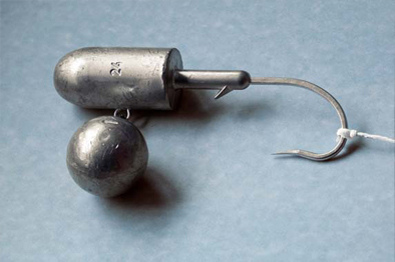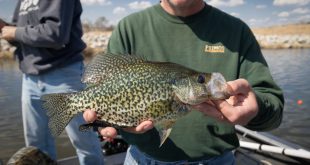I am going deep with this blog post, no pun intended. Have to start with a story. . . .
Several years back on a late October day, I spent some time fishing Elwood Reservoir with the maintenance man from our headquarters facilities (yes, even our maintenance men hunt and fish!). We found some baitfish in deep water, in fact I will never forget watching the depth-finder, jigging a Rattle Snakie in 51 feet of water, when I hooked a really nice fish–ended up being a 28-inch walleye.
I was concerned about that fish because I wanted to release her, but had caught her from such deep water. I remember getting her back in the water and she went vertical straight for the bottom like she was shot from a cannon. We never saw that fish the rest of the day and assumed she survived the catch & release. The rest of the story is that fish had a tag, likely a tag I had put in her. A couple of years later the survival of that fish was confirmed as another angler caught her and reported the tag number (Fish Recycling).
Why was I concerned about her survival? To answer that is going to require a bit of a lesson in fish anatomy and physiology. Pull up a chair, I warned you I was going deep.
Swim Bladder
Most fish are neutrally-buoyant in the water; they neither fight to stay down nor work to stay up. They accomplish that by regulating the amount of gas in their swim bladder. SCUBA divers do the same thing by adding or releasing oxygen from a vest they wear. Fish can make depth changes of several feet without having to adjust the gas in their swim bladder, but for most fish, a rapid depth change of dozens of feet can cause problems. If you remember your Physics or Chemistry, you know that gases expand as pressure declines. A walleye brought from 51 feet of water to the surface can experience so much expansion of the gas in its swim bladder that the swim bladder becomes like an inflated balloon. That “balloon” can prevent fish from returning to their ambient depth. In severe cases the expanded swim bladder may protrude out of the mouth, turning the stomach inside out and forcing it out of the mouth. Exopthalmia or “bug-eyes” are another symptom of fish with distended swim-bladders.
Some species of fish have a duct between their swim bladder and esophagus and can “burp” expanding gases as they are brought up from the depths. Catfish, trout and salmon species can do this and you may notice the rising gas bubbles as those fish burp gases while being reeled to the surface. Unfortunately, other species of fish like walleyes, crappies, and bass cannot burp expanding gases, and in fact, regulation of the pressure in their swim bladder may take hours.
Barotrauma
The big word that pointy-headed fisheries biologists use to describe the condition of gas expansion, distended swim bladders, and other harm caused when fish are rapidly brought to the surface is barotrauma. I have hesitated to mention barotrauma before because in almost all Nebraska waters it is NOT a problem. Unless a fish has been caught out of at least 25 or 30 feet of water or more, barotrauma usually is not a cause for concern. Seldom are fish caught from water deeper than that in Nebraska. However, there are times and situations even in Nebraska when some fish are caught from deep water. Obviously, as my story indicated, vertical jigging for walleyes and other predator fish can be very effective in the late fall on Nebraska reservoirs, and at times those fish are slabbed-up from as much as 50 feet of water and maybe even more. Also on Elwood Reservoir I have caught walleyes while shore-casting that had distended swim bladders–those fish had made a quick rush from deep water to capture shallow water baitfish, but when I hooked them their swim bladder expanded and they could not get back down to depth. I have also seen some Nebraska ice-fishing situations where fish caught from deep water have exhibited signs of barotrauma.
What can be done for fish with barotrauma? What if an angler has to or wants to release those fish?
Fizzing
The popular approach has been to use a hypodermic needle to release the gas pressure from the swim bladder; a process popularly called “fizzing”. When the swim bladder is punctured, the gas pressure is released, “fizzed”. Some anglers carry hypodermic needles with them to accomplish this; there even are commercial products available, Vent For Life. However, research that has been done on “fizzing” has NOT shown that this practice works well. First of all, there is the little problem of poking fish with hypodermic needles–if a person does not know exactly where to poke, there are a bunch of vital organs that can be punctured. Secondly, fizzing fish requires more handling of the fish, and even though the gas pressure in the swim bladder may be released, there is other damage from barotrauma and fizzing does nothing to stop or alleviate that damage. Lastly, I have seen fizzed fish sink to the bottom of a livewell or holding tank indicating that their “cure” might have been as bad or worse than the “disease”.
Recompression
Where barotrauma is a concern, I have suggested that there might be mechanical methods that would be better for the fish–some way of returning fish to depth where the water pressure would re-compress their swim bladder. I have not had the opportunity to experiment with this myself, but I found some ideas that are a lot better than mine. . . .
Barotrauma is a much bigger issue in marine fisheries. Instead of capturing fish from dozens of feet of water, in some marine fisheries, fish are brought to the surface from HUNDREDS of feet of water. In some of those fisheries, regulations REQUIRE the release of some of those fish. Fish suffering from barotrauma that are just tossed back in the water are doomed to float on the surface like a balloon and have very little chance of survival. Fortunately, in marine fisheries there have been a lot of anglers and pointy-headed fish biologists looking for better ways to handle fish caught from deep water.
I found this video on the internet that explains it all better than I have. I know, I know, it is a 9 1/2 minute-video and no one takes that much time to learn anything anymore. Do it, watch the whole thing. You will learn something and I love the rap song at the end of the video. If it helps, hear “walleye” every time the words “rock fish” are said.
Hope that song gets stuck in your head, it is in mine!
There were several commercially-available re-compression/deep-water release tools mentioned in that video. Here are links to a few of them, Shelton Fish Descender , RockLees Fish Descending Device , SeaQualizer .
Of course the weighted milk crate is a homemade design, and I have seen a lot of other homemade devices like fish grippers that have been adapted with a line tie on the top of the handle and a heavy weight on the bottom of the handle. Or an extra heavy jig, like those used for halibut, with the barb filed down and the line attached to the bend of the hook.
The commercially available products are not very expensive and could easily be adapted to those situations where they are needed in Nebraska. However, I am betting most Nebraska anglers who have a need for such a device might be more likely to go the DIY route and create something that will work. These products should give you some ideas.
If you are catching fish from deep water and they are suffering from barotrauma, keep a couple of things in mind: First of all, if you do not have to pound those deep-water fish, then MOVE! Reeling a bunch of 6-inch crappies to the surface from 45 feet of water is probably senseless–pull off and look for some bigger fish. If you have all the fish you want to harvest, look for other fish to catch in shallower water.
However, I fully understand that deep-water, vertical jigging in late fall is one of the best ways to catch some of the biggest fish of the year, and by law or by choice anglers will want to catch & release at least some of those fish. In that case, plan ahead; have a deep-water release device ready to get those fish back down to where they came from. Always land fish as quickly as possible! Reeling them slowly to the surface will not abate the effects of barotrauma and will prolong the time it takes to get those fish back down. Also, as I always say, handle the fish as little as possible. Keep them in the water as much as possible and do NOT let them flop on the bottom of the boat. Have hook removal tools ready and use them. As quickly as possible, get the fish back down to the water from which they were caught. You might release the fish to see if they can power themselves back down, but if you are catching them from deep water it probably would be faster to use a deep-water release device and get them back down there ASAP.
Again, do not make this out to be a bigger problem than it is–in most Nebraska fishing situations barotrauma simply is never an issue. But, in those few situations where it is, there are ways to handle those fish that are to be released. These may be marine techniques foreign to most inland, freshwater anglers, but they are out there and they work! We can do it too!
Give me a beat. . . .
“. . . Rock it like a Walleye, Sink and Swim!”
Walleye Recompression, Baby.
 Nebraskaland Magazine
Nebraskaland Magazine





